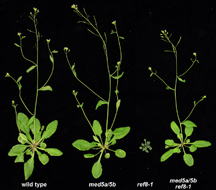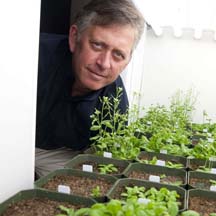Discovery could yield more efficient plants for biofuels
March 17, 2014
 |
|
The production of lignin in the Arabidopsis plant second from right has been disrupted, resulting in severe dwarfing. Making mutations to two MED5 genes in the dwarfed plant can restore normal growth and levels of lignin production, as seen in the plant on far right. (Purdue University image/Clint Chapple) |
WEST LAFAYETTE, Ind. - Genetically modifying a key protein complex in plants could lead to improved crops for the production of cellulosic biofuels, a Purdue University study says.
Clint Chapple, distinguished professor of biochemistry, and fellow researchers generated a mutant Arabidopsis plant whose cell walls can be converted easily into fermentable sugars but does not display the stunted growth patterns of similar mutants. The finding could maintain yield while reducing the need for costly pretreatment processes that make cellulosic biofuels more inefficient to produce than corn ethanol.
"This study opens the door to a whole new set of technologies we never could have imagined," Chapple said. "This finding is not the silver bullet that will suddenly make the wide-scale production of cellulosic biofuels possible, but it is a very important step forward."
Cellulosic biofuels are made from the sugars in the cell walls of wood, grasses and the inedible parts of plants. But production of cost-efficient cellulosic biofuels is currently limited by lignin, the compound that gives plants strength and structural integrity. Lignin binds tightly to the main component of plant cell walls, cellulose, which is made of simple sugars. Freeing cellulose from lignin so that it can be broken down into sugars and fermented into fuel requires expensive and complicated pretreatment processes.
 |
|
Clint Chapple |
Scientists have probed ways of genetically modifying plants to weaken lignin's grip, but disrupting the lignin biosynthetic pathway in plants often leaves them dwarfed and low-yielding.
"We've always known we couldn't eliminate lignin entirely," Chapple said. "If there isn't enough lignin in the cell walls, the plant's water conducting system will collapse. For the plants, it's like trying to drink a milkshake through a paper straw. They need the strength lignin provides to pull water up from their roots."
The challenge, Chapple said, was to find a way of preserving lignin's key structural functions while preventing it from interfering with the use of cellulosic materials.
Chapple and his fellow researchers took an Arabidopsis mutant plant in which the lignin biosynthetic pathway had been interrupted - and was, therefore, weak and dwarfed - and made two additional mutations by knocking out two plant genes known as MED5a and MED5b.
The triple mutation resulted in a healthy plant with normal growth and wild-type levels of lignin.
"When I saw this plant, I thought it couldn't possibly be true," Chapple said. "We thought plants like this would have too many architectural problems to grow properly. But what this indicates is that plants with a blocked lignin pathway can grow - they're just 'choosing' not to."
The study showed that suppressing the MED5 genes took away the mutant plant's ability to sense the disruption in its lignin biosynthetic pathway. It responded by growing normally and producing a highly unusual type of lignin that interfered far less with the breakdown of cell walls into their sugar components than lignin in wild-type plants. When treated with enzymes, the triple mutant yielded significantly more glucose than normal plants.
"We've never worked with plant material like this before," Chapple said. "It gives up its sugars quite easily and eliminates the need for pretreatment, which is a big component of the expense of making cellulosic biofuels."
While lignin is considered a waste material in current biofuels production, the simple composition of the novel lignin - which is made up almost exclusively of a single type of alcohol - could make it a potential fuel source in the future, Chapple said.
The discovery could also lead to the development of more digestible forage crops, which could improve weight gain in livestock.
Chapple cautioned that suppressing genes in MED5 is not necessarily a quick fix to the complications of producing cellulosic biofuels. Mutations in MED5 can negatively affect other important plant processes. But the study gives important insights into plant metabolism and how plant cell walls are made, he said.
"Learning that this pathway exists gives us an opportunity to find out how it works. These plants aren't dwarfed for the reason we thought they were. Now we can reexamine other ways of modifying lignin that we'd thought were useless."
The study was published Sunday (March 16) in Nature and is available at http://www.nature.com/nature/journal/vaop/ncurrent/full/nature13084.html.
The Office of Basic Energy Sciences of the U.S. Department of Energy and the Life Sciences Research Foundation provided funding for the research.
Writer: Natalie van Hoose, 765-496-2050, nvanhoos@purdue.edu
Source: Clint Chapple, 765-494-0494, chapple@purdue.edu
Note to journalists: From March 17-23, Clint Chapple can best be reached through his email address, chapple@purdue.edu, or through Natalie van Hoose, 765-496-2050 or nvanhoos@purdue.edu
ABSTRACT
Disruption of Mediator rescues the stunted growth of a lignin-deficient Arabidopsis mutant
Nicholas D. Bonawitz 1; Jeong Im Kim 1; Yuki Tobimatsu 2; Peter N. Ciesielski 3; Nickolas A. Anderson 1; Eduardo Ximenes 4; Junko Maeda 1*; John Ralph 2, 5, 6; Bryon S. Donohoe 3; Michael Ladisch 4, 7; Clint Chapple 1
1 Department of Biochemistry, Purdue University, West Lafayette, IN 47907, USA
2 Department of Biochemistry, University of Wisconsin-Madison, Madison, WI 53706, USA
3 Biosciences Center, National Renewable Energy Laboratory, Golden, CO 80401, USA
4 Department of Agricultural and Biological Engineering and the Laboratory of Renewable Resources Engineering, Purdue University, West Lafayette, IN 47907, USA
5 Department of Biological Systems Engineering, University of Wisconsin-Madison, Madison, WI 53706, USA
6 DOE Great Lakes Bioenergy Research Center, and Wisconsin Energy Institute, University of Wisconsin-Madison, Madison, WI 53726, USA
7 Weldon School of Biomedical Engineering, Purdue University, West Lafayette, IN 47907, USA
* Current address: Department of Agronomy, University of Wisconsin-Madison, Madison, WI 53726, USA
E-mail: chapple@purdue.edu
Lignin is a phenylpropanoid-derived heteropolymer important for the strength and rigidity of the plant secondary cell wall. Genetic disruption of lignin biosynthesis has been proposed as a means to improve forage and bioenergy crops, but frequently results in stunted growth and developmental abnormalities via an unknown mechanism. Here we show that the phenotype of a lignin-deficient Arabidopsis mutant is dependent on the transcriptional coregulatory complex Mediator. Disruption of the Mediator subunits REF4/MED5a and RFR1/MED5b rescues the stunted growth, lignin deficiency, and widespread changes in gene expression exhibited by the phenylpropanoid pathway mutant ref8, without restoring the synthesis of guaiacyl and syringyl lignin subunits. Cell walls of rescued ref4 rfr1 ref8 plants instead contain a novel lignin consisting almost exclusively of p-hydroxyphenyl lignin subunits, and moreover exhibit substantially facilitated polysaccharide saccharification. These results demonstrate that guaiacyl and syringyl lignin subunits are largely dispensable for normal growth and development, implicate Mediator in an active transcriptional process responsible for dwarfing and inhibition of lignin biosynthesis, and suggest that the transcription machinery and the signaling pathways responding to cell wall defects may be important targets to include in efforts to reduce biomass recalcitrance.
Ag Communications: (765) 494-2722;
Keith Robinson, robins89@purdue.edu
Agriculture News Page

